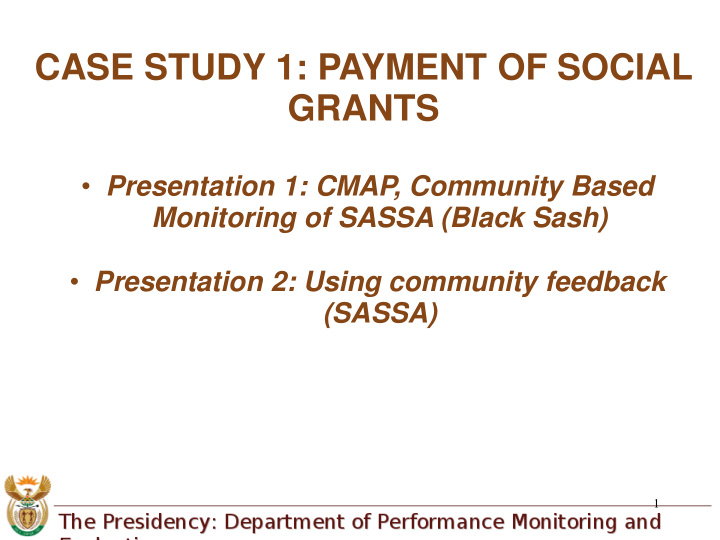



CASE STUDY 1: PAYMENT OF SOCIAL GRANTS • Presentation 1: CMAP, Community Based Monitoring of SASSA (Black Sash) • Presentation 2: Using community feedback (SASSA) 1
Presentation 1: CMAP, Community Based Monitoring of SASSA (Black Sash) 2
OBJECTIVES OF THE APPROACH • To cultivate a civil society initiative for monitoring and advocacy practice in identified marginalised communities. This is located in townships, peri- urban and rural areas across South Africa • Accountable and standardized monitoring of government’s service delivery by identified trained monitors of civil society organisations will form the basis for dialogue & advocacy, at community and policy levels for affordable, appropriate and dignified service delivery. 3
DESCRIPTION OF HOW THE TOOL WORKS • 270 community based civil society entities in 9 provinces were identified, recruited and trained. Selection of monitors were particularly chosen from marginalized communities to engage government from an informed basis through monitoring and advocacy. • Monitoring instruments were developed for prioritized service delivery needs in areas with monitoring organisations. Monitors nominated by these organisations and then trained on the use of the instruments. • Government departments engaged for permission for monitors to access the service delivery sites to monitor. • Coordinated community monitors maintain a regular and disciplined presence at sites of service delivery, and record observations against standardised instruments. • Information from monitoring is returned to Black Sash and captured and analysed online. • Reports generated fed back to CSOs and the relevant government departments for comment. • Reports then made public on project partners websites, and used in capacity building sessions with monitors 4
KEY AREAS OF SUCCESS • Exemplary response from SASSA to the projects and the benefits and challenges monitoring feedback brings to this Agency. • SASSA’s openness and willingness to be scrutinized by the monitors and their acceptance of the project’s findings without prejudices has been very commendable. • Beneficiaries’, CSOs’ and communities’ heightened awareness to question the quality of public service delivery • Visible improvements to the delivery of SASSA services in the Western Cape . 5
CHALLENGES IN IMPLEMENTATION • Government departments’ resistance to permit monitors to access the service delivery sites freely to do the monitoring – we have experienced particular difficulties in getting a commitment from the Department of Home Affairs after engaging the department for more than a year. • Out of pocket cost to some monitoring organisations to undertake monitoring actions are too high for them to bear – especially rural areas and where SASSA and departments is furthest from them 6
LESSONS: HOW GOVERNMENT CAN USE INFORMATION COLLECTED THROUGH THIS APPROACH • Interprovincial learning between provinces – various approaches can be considered to improve quality of service • Results and feedback through CMAP monitoring reports can assist departments in their strategic plans and help provide better insight for smarter and a more responsive basket of services. • Can be used to make overall service improvements in terms of human and system resources at service site -, provincial - or at a national level • Challenge and motivate for additional funds to aid the improvement of the service where needed • CMAP reports can be used alongside the findings of departmental surveys and academic research projects. 7
LESSONS: HOW CAN THIS APPROACH BE USED IN OTHER SECTORS? • Quality, real-time, impartial and community-owned feedback on the delivery of services is critical to service improvements, as opposed to expensive desktop or consultant driven surveys done where findings are released years later or are based on old data. • Working with local CSOs and monitors who are known to the public they monitor, encourages open and honest accounts of service delivery experiences. • Encouraging the physical presence of a visible monitor is essential in ensuring that the monitoring process is known to all affected – this mere presence in itself can improve services. • Important tool to link Constitutionally-entrenched rights with direct experience at the service point – experientially based tool to help realize human rights 8
LESSONS: HOW CAN THIS APPROACH BE USED IN OTHER SECTORS? • CMAP can motivate the beneficiary and/or monitor around human rights – in particular the right to access benefits in a dignified way and the right to efficient and effective service delivery. • Organisations do local advocacy with the regional or local manager to the extent that the manager is authorized and willing to realize the recommendations proposed. • Organisations do national advocacy with policy makers, implementers, and decision makers on a national level to the extent that national decision makers are willing and able to take up the recommendations proposed based on the findings from the monitoring. • Organisations are able to use the information gathered, the actual report, the findings and/or recommendations in submissions, presentations, meetings and various other platforms to influence a policy or legislative direction 9
Presentation 2: Using community feedback (SASSA) 10
Recommend
More recommend